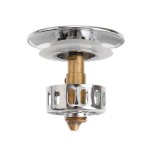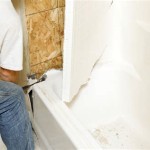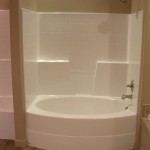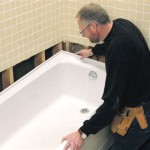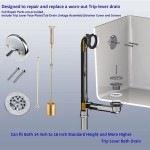Can You Install a Bathtub Surround Over Tile? A Comprehensive Guide
The process of remodeling a bathroom can be a daunting undertaking, often involving significant demolition, expense, and disruption to household routines. One common question that arises during bathroom renovations centers on the feasibility of installing a new bathtub surround directly over existing tiles. While seemingly a straightforward solution to bypass the time-consuming task of removing the old tile, the answer is complex and depends on a variety of factors. This article provides a comprehensive overview of the considerations involved in installing a bathtub surround over tile, exploring the potential benefits, drawbacks, and necessary preparations.
The decision to install a bathtub surround over existing tile should not be taken lightly. A thorough evaluation of the existing conditions and an understanding of the potential implications are crucial for ensuring a successful and long-lasting installation. Ignoring these factors can lead to problems such as poor adhesion, water damage, and ultimately, the need for more extensive and costly repairs in the future.
Assessing the Existing Tile Condition
Before even considering installing a bathtub surround over tile, a meticulous assessment of the existing tile surface is paramount. The integrity of the underlying structure and the condition of the tiles themselves will dictate the viability of this approach. Any structural issues must be addressed before proceeding. Look for these issues when assessing your tile:
Stability: The most crucial aspect is the stability of the existing tile. Loose, cracked, or otherwise damaged tiles must be addressed before moving forward. If the tiles are not firmly adhered to the substrate, the new surround will inherit these instability issues, ultimately leading to failure. Individual loose tiles can sometimes be re-adhered using appropriate bonding agents, but a significant number of loose or damaged tiles may necessitate complete removal.
Surface Integrity: The tile surface must be free from any substances that could interfere with adhesion. This includes soap scum, mildew, grease, and loose grout. A thorough cleaning with a suitable degreaser and mildew remover is essential. The surface should also be lightly scuffed to provide a better key for the adhesive used to install the new surround. Ignoring this step can result in delamination and premature failure of the surround.
Grout Condition: The condition of the grout lines is another important consideration. Crumbling, cracked, or missing grout should be repaired or replaced. Ideally, the grout lines should be flush with the tile surface to provide a smooth and even surface for the new surround. Uneven grout lines can create voids and prevent proper adhesion, leading to unevenness and potential water intrusion.
Levelness: Evaluate the overall levelness of the tiled surface. Significant unevenness can make it difficult to achieve a smooth and professional-looking installation. Minor imperfections can often be compensated for with shims or additional adhesive, but substantial variations in levelness may require leveling compound or, again, the removal of the original tile.
Material Compatibility and Adhesion
Selecting the right type of bathtub surround and adhesive is critical for a successful installation over tile. Not all surrounds and adhesives are created equal, and compatibility between the two is essential for achieving a strong and lasting bond. Consider these crucial aspects:
Surround Material: Bathtub surrounds are available in a variety of materials, including acrylic, fiberglass, PVC, and composite materials. Each material has its own unique properties and requirements for adhesion. Check the manufacturer's recommendations for the specific surround material being used. Some materials may require specialized adhesives or surface preparation techniques.
Adhesive Selection: Choosing an appropriate adhesive is paramount. Construction adhesives specifically designed for bonding to tile surfaces are crucial. These adhesives typically have a high initial tack and provide a strong, durable bond. Epoxy-based adhesives can also be an option, particularly for bonding to non-porous tile surfaces. Always refer to the adhesive manufacturer's instructions and ensure that the adhesive is compatible with both the surround material and the tile surface. Applying the adhesive per the manufacturer’s recommendation is vital.
Surface Preparation: Proper surface preparation is essential for maximizing adhesion. After cleaning and scuffing the tile surface, consider applying a primer that is specifically designed to improve adhesion. Primers can help to bridge the gap between the tile surface and the adhesive, promoting a stronger and more reliable bond. Test adhesion in an inconspicuous area before committing to a full installation.
Moisture Resistance: Ensure the chosen adhesive is highly water-resistant or waterproof. The bathtub surround area is constantly exposed to moisture, and an adhesive that is not resistant to water will eventually degrade, leading to the surround detaching from the tile. Check the adhesive's specifications and certifications to ensure it meets the requirements for a wet environment.
Addressing Potential Problems and Challenges
Installing a bathtub surround over tile is not without its potential problems and challenges. Anticipating these issues and having a plan to address them is essential for a successful outcome. The following are some of the potential problems and challenges:
Increased Thickness: Installing a surround over tile will inevitably increase the overall thickness of the wall. This can create issues with trim work, plumbing fixtures, and other bathroom elements. Consider the impact of the added thickness on the surrounding areas and make necessary adjustments to ensure a seamless transition. The drain will also likely need adjustments if the tub height is increased.
Water Intrusion: If the installation is not done properly, water can seep behind the surround and become trapped between the surround and the tile. This can lead to mold growth, mildew, and structural damage. Ensure all seams and joints are properly sealed with a high-quality sealant to prevent water intrusion. Regular inspection and maintenance of the sealant are crucial for preventing future problems.
Weight Considerations: The added weight of the new surround can put additional stress on the wall structure. Ensure the wall is capable of supporting the added weight, especially in older homes. If the wall is weak or unstable, reinforcement may be necessary.
Warranty Issues: Some surround manufacturers may void their warranties if the surround is installed over existing tile. Check the manufacturer's warranty terms and conditions before proceeding with the installation. Installing the surround according to the manufacturer's recommendations is crucial for maintaining the warranty.
Aesthetics: Even with careful preparation, installing a surround over tile may not always result in a perfectly smooth and seamless finish. Any imperfections in the existing tile surface will be reflected in the new surround. Consider whether the potential aesthetic compromises are acceptable before proceeding. Covering the tile can lead to a cleaner and updated look, but can also look unprofessional if done incorrectly.
Code Compliance: Check local building codes to ensure that installing a surround over tile is permitted and meets all applicable requirements. Some jurisdictions may have specific regulations regarding moisture barriers, ventilation, and other aspects of bathroom construction. Ignoring building codes can result in fines and delays.
In conclusion, installing a bathtub surround over tile is a viable option under certain circumstances, but it requires careful planning, preparation, and execution. Prioritizing the assessment of the existing tile condition, selecting compatible materials, and addressing potential problems are crucial for achieving a successful and long-lasting installation. Ignoring these factors can lead to costly repairs and ultimately, the need to remove the existing tile and start from scratch. Always consult with a qualified professional if unsure about any aspect of the installation process.

Installing Tub Surround Over Tile

Installing Tub Surround Over Tile

Installing Tub Surround Over Tile

Installing Tub Surround Over Tile
.jpg?strip=all)
Installing The Ceramic Tile Tub Surround My Old House Ibuildit Ca

What Is A Tub Surround How To Choose For Your Bathroom Badeloft

How To Install A Shower Surround Over Tile Hunker

Tile Under Tub Should You Do It

How To Tile A Bathtub Surround The Handyman S Daughter

Can I Glue A Tub Surround Over Existing Tile Yes Here S How Worst Room
Related Posts

